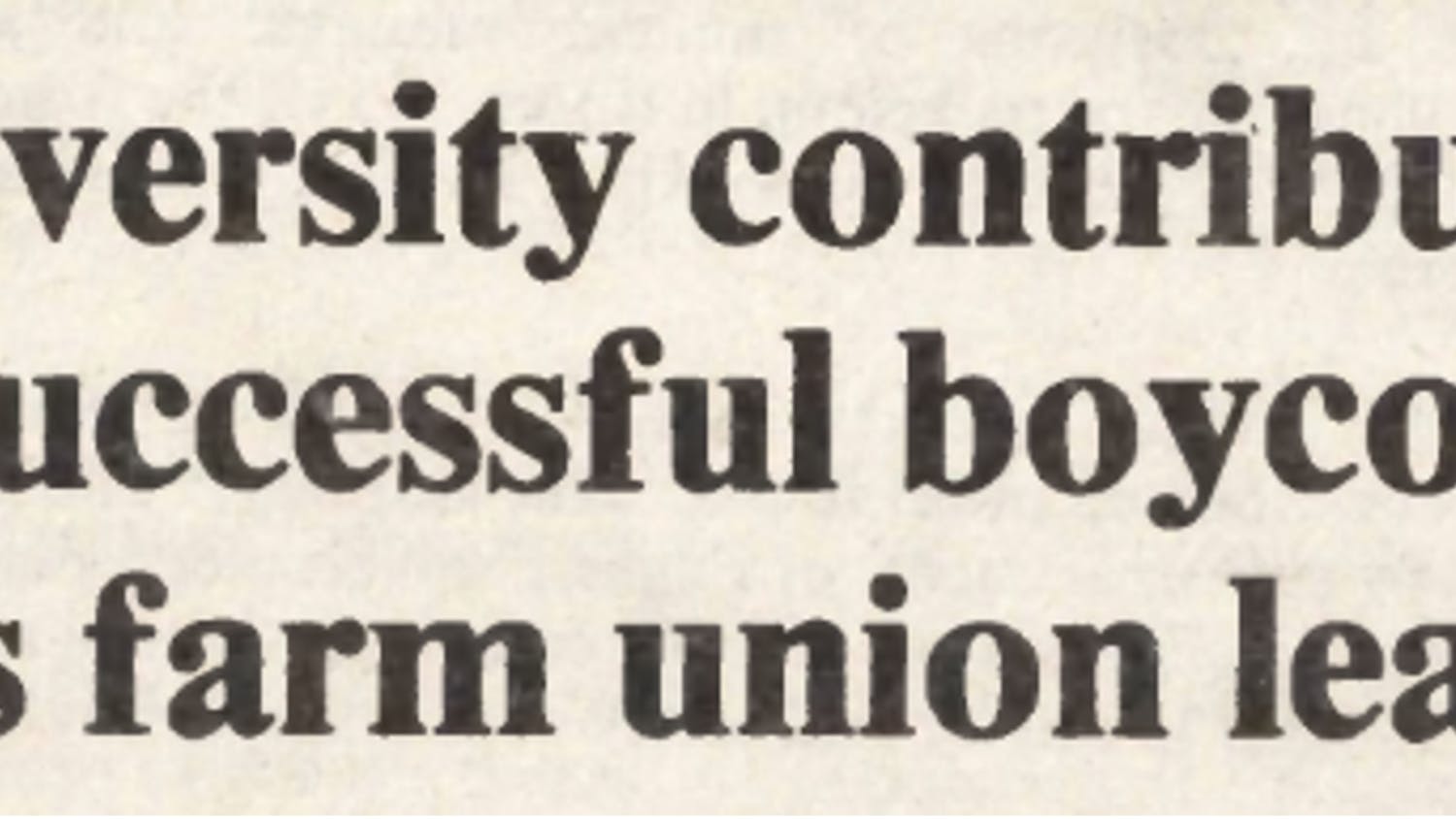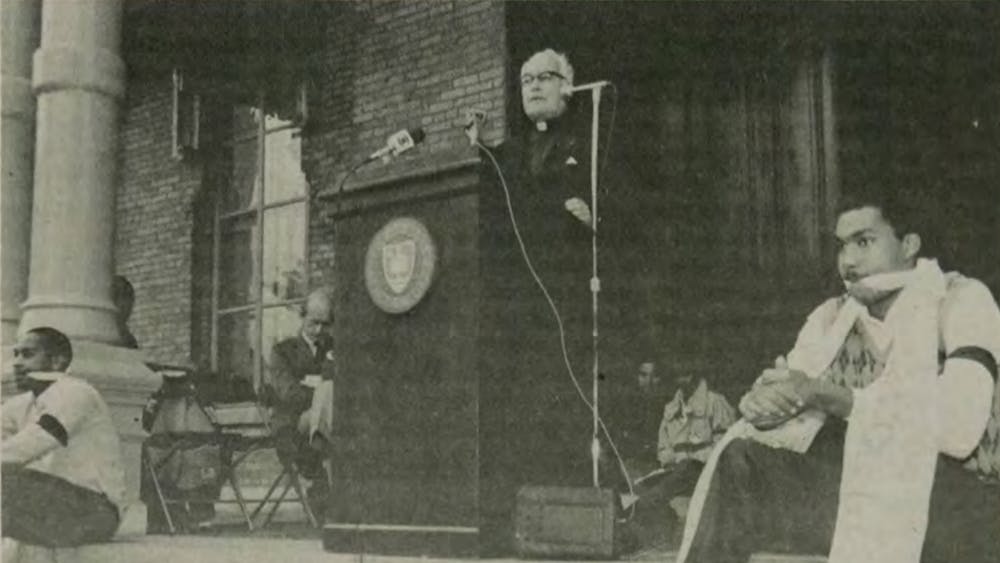
The Notre Dame community has often held a mirror to Valentine’s Day, revealing multifaceted reflections on love, courtship and the holiday’s commercial sheen. This retrospective delves into the musings and machinations of students across decades, from tongue-in-cheek guides for lovelorn Domers to critical contemplations on the nature of love. We trace the history of Feb. 14 on campus, a date marked by both cynicism and celebration, through the voices that have shaped Notre Dame’s discourse on this polarizing day of romance.
A How To Guide: Valentine’s Day at Notre Dame
Feb. 14, 1989| Ian Mitchell | Feb. 14, 1995 | Kim Massman | Feb. 13, 2007 | Chris Mueller | Feb. 2, 2010 | Molly Madden | Feb. 10, 2012 | Brenna Williams | Researched by Cade Czarnecki
While many Notre Dame students lament Valentine’s Day, some Domers throughout the years have offered their advice on how to improve the day of love.
In 1995, the famed “Love Goddess” received numerous questions asking how to make Feb. 14 in South Bend a day to remember. Her advice —filled with subtle quips — painted a picture of what a possible romantic evening could look like for a couple as well as for any lonely bachelors.
Dinner suggestions for a couple included the Morris Inn (for cheapskates per Love Goddess) or the LaSalle Grill (for those with a little extra coin in their pocket per Love Goddess). She emphasized that flowers and opening doors were a must, but the Love Goddess also recommended going out for coffee after dinner in order to spice up the night.
For those without a date, the Love Goddess provided a game plan: take a shower and then head to the bookstore. She suggested that an examination of the items being bought by a person of potential love interest would tell a potential significant other all they needed to know.
While not having quite the same notoriety as the Love Goddess, a student in 1989 also shared their vision for the perfect Notre Dame Valentine’s Day date. Their recommendation entailed calling an unknown peer, using a pickup line, taking the peer to the dining hall and then ending the night watching television in LaFun — a night likely put forth in jest but a potential reality for those stranded on campus on Feb. 14.
Writing in a slightly more wholesome and less comical tone, Brenna Williams ‘12 suggested in 2012 that single Domers should head to the Huddle with their friends, pick up a pint of ice cream and then find a large television to watch a movie.
Finally, taking a middle road between humor and legitimate wisdom, an article that originally appeared in Penn State University’s Daily Collegian was republished in The Observer, and it suggested that on Valentine’s Day, a single person should take someone out who has always been there for them. That someone should be “someone you find interesting” and “someone you like more sober than drunk.” While well-intentioned, one wonders what experiences the author may have had to lead to this wisdom. They offered some insight into their true beliefs about Valentine’s Day by characterizing the holiday as one that “yields as many hurt feelings as it does happy nights.”
A Call for Organic Love: Notre Dame’s Criticisms of Valentine’s Day
Feb. 14, 1985 | Amy Stephen | Feb. 14, 1994 | Kenya Johnson | Feb. 12, 1996 | Dan Cichalski | Feb. 13, 2006 | Associated Press | Researched by Lilyann Gardner
“Love makes you blind” is a common phrase of speech, but it becomes especially relevant with critics of the famed Feb. 14 holiday who believe the masses have unwittingly fallen into a consumerist trap rather than being struck by cupid’s arrow.
Members of the Notre Dame community have echoed this sentiment and emphasized that big corporations have commercialized Valentine’s Day to the point that gifts are not being given out of love but out of obligation. The resulting pressure to find the perfect gift has thus created an inauthentic relationship culture.
Amy Stephan ‘87, Project Manager for The Observer in 1985, aired her concerns by writing, “The sad thing is that Valentine's Day makes us translate our affection into dollars and cents. Cliched as it may sound, most people show their ‘love’ in little ways. They shovel someone’s sidewalks, help out with homework, even take out the garbage. Not very romantic, but a little more real than a rose and a song.”
These Valentine’s Day disparagers claim the holiday overshadows the importance of showing devotion everyday and drives people without a relationship to search for love in all the wrong places.
Video-dating services and printing personal ads in the 1990s quickly transformed to dating apps in the 2000s and were deemed as means of rushing a relationship that is meant to form organically. Observer sources held the belief that individuals must have patience, and only then will everything in the love department work out accordingly.
In the meantime, however, Dan Cichalski ‘98, Accent Copy Editor, shared his way of passing the time.
“I’ll celebrate this holiday with some of my best friends, to whom I’ve grown a lot closer in recent months. And I’m sure that some day I’ll like Valentine’s Day again. I’ll be married and look forward to sharing the day with my wife.”
It seems that destiny as opposed to roses and chocolate might just be the key to making Valentine’s Day a little less bleak.
From Star Wars to Heartstrings: A Valentine’s Day Change of Heart
Feb. 14, 1994 | Eric Ruethling | Feb. 14, 1995 | Eric Ruethling | Researched by Thomas Dobbs
In the span of a year, the perspective on Valentine’s Day held by Eric Ruethling ‘96 had undergone a subtle yet telling transformation. Initially, the day evoked in him nothing short of disdain. Having never been one for sentimentality and preferring the action-packed realms of Star Wars over traditional Valentine’s Day activities, he found the day’s romantic gestures particularly off-putting, as they were at odds with his straightforward, no-nonsense demeanor. “There are no days in the year that I have more dislike for than Valentine's Day,” he declared, a sentiment rooted in the memories of compulsory card-giving that clashed with his youthful, rebellion-infused ethos.

Ruethling’s childhood protest was a silent one, marked by whining against a mother’s insistence on spreading cheer “TO EVERYONE” — an egalitarian approach to affection that his peers seemingly did not reciprocate, judging by the sparse harvest of cards he reaped.
Fast forward a year, and we witness a shift, albeit not towards a wholesale embrace of Feb. 14. While the commercialization of affection — “a corporate invention” that commodifies primeval emotions — remains a thorn in his side, his diatribe has softened, mellowed by a growing awareness of the complexity surrounding the concept of love. No longer wielding his pen with a bitter edge, he muses on love’s elusive essence, a philosophical approach that hints at maturation.
“We live in an age where love can be bought and sold,” he reflects, acknowledging the materialism that taints the day‘s purportedly romantic core. Yet, his critique now spares those who seek to imbue their gifts with genuine sentiment, suggesting a nuanced understanding that true affection may indeed be expressed, albeit occasionally, through material means.
Reflecting on John Alexander Joyce’s poignant line, “I shall love you in December, with the love I gave in May,” our once vehement critic of Valentine’s Day now seems to entertain the possibility of love’s constancy through the seasons. Though Ruethling maintains a healthy skepticism toward the day’s overt commercialism, he no longer dismisses it outright. He stands on neutral ground, proposing that love — authentic and unmarred by materialism — might indeed exist beyond the confines of a single calendar day.
Ruethling’s journey from contempt to contemplative critique mirrors the evolution of many a young heart, learning that the world, in all its commercial clamor, might still harbor pockets of genuine emotion worth celebrating. “I am not against the truly meaningful gift,” he admits, a concession to the possibility of authenticity amidst the cacophony of capitalism. It is a stance that recognizes the imperfections of Valentine’s Day while holding out hope for what it might yet represent.










